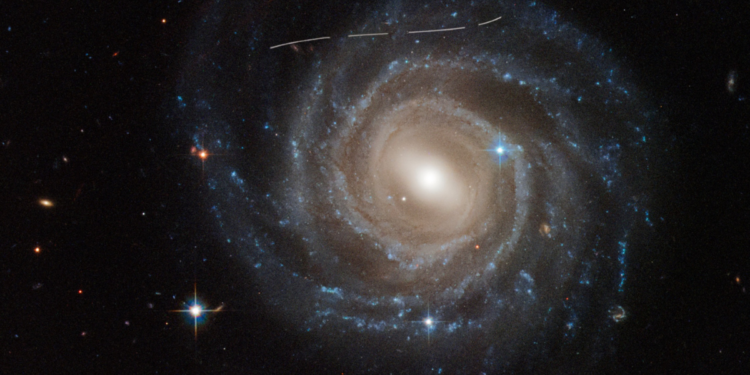This magnificent island universe, NGC 2217, captured by the Hubble Space Telescope, offers a captivating glimpse into the structure and evolution of barred spiral galaxies. Located roughly 65 million light-years away in the constellation Canis Major, NGC 2217 boasts a dazzling central bar, tightly wound spiral arms, and a hidden supermassive black hole at its core.
A Dazzling Bar: The Conductor of Stellar Creation
The defining feature of NGC 2217 is its prominent central bar, a vast region packed with stars. Stretching an estimated 100,000 light-years across – remarkably similar in size to our own Milky Way galaxy – this bar plays a crucial role in the galaxy’s ongoing story. It acts as a cosmic conductor, funneling gas from the outer disk inwards. This gas, a rich interstellar brew of hydrogen, helium, and other elements, serves as the raw material for star formation.
Fueling the Stellar Nursery: From Gas to Stars
As the gas gets squeezed towards the center by the bar, it becomes denser and hotter. Imagine a cosmic pressure cooker! This creates a prime environment for star formation. The brilliant starlight illuminating the Hubble image is a testament to this ongoing stellar nursery within the central bar. Here, dense clouds of gas collapse under their own gravity, igniting the nuclear fusion process that gives birth to new stars. These young stars bathe the central region in their brilliance, contributing to the dazzling bar that defines NGC 2217.
A Dramatic Fate: The Supermassive Black Hole’s Feast
Not all the gas funneled inwards is destined to become stars. Some faces a more dramatic fate, being consumed by a supermassive black hole residing at the very heart of NGC 2217. These black holes, harboring masses millions to billions times that of our Sun, exert an immense gravitational pull that even light cannot escape. As gas spirals inwards towards the black hole, it undergoes a dramatic heating process, radiating tremendous amounts of energy across various wavelengths of the electromagnetic spectrum. This superheated gas swirling around the black hole is called an accretion disk, and it can be a source of incredibly powerful emissions.
Unveiling the Bigger Picture: A Tapestry of Stars and Gas
The captivating Hubble image is a composite, incorporating data from Pan-STARRS to reveal the intricate distribution of stars and gas throughout the vast galactic disk. Studying galaxies like NGC 2217 allows astronomers to decode the grand narrative of galactic evolution. By tracing the movement of gas, the birthplaces of new stars, and the influence of the supermassive black hole, scientists can piece together the story of how these majestic structures form and change over time. NGC 2217 serves as a stunning reminder of the intricate processes that govern the birth, life, and death of stars within a galactic crucible.
A Window into the Cosmos: A Quest for Understanding
NGC 2217 is just one example of the countless galaxies that populate our vast universe. As we continue to develop more powerful telescopes and hone our observational techniques, astronomers can delve deeper into the secrets these galaxies hold. Future observations promise to reveal even finer details about NGC 2217’s structure, the composition of its gas and dust, and the potential for star formation within its spiral arms. By studying galaxies like NGC 2217, we not only gain a deeper understanding of these magnificent cosmic structures, but also learn more about our own place in the grand tapestry of the cosmos. Each new discovery brings us closer to unlocking the mysteries of the universe and our place within it.



















